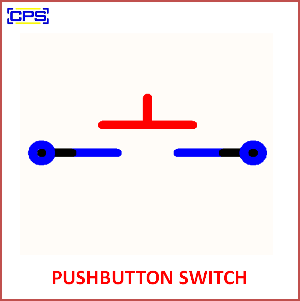A Pushbutton Switch is a simple mechanical switch that is activated by pressing a button. It is typically used to open or close an electrical circuit, either momentarily or permanently, depending on the type of pushbutton switch.

Key Features of a Pushbutton Switch
- Momentary vs. Latching:
- Momentary Pushbutton: Returns to its original position after being pressed (i.e., it only closes or opens the circuit while the button is pressed).
- Latching Pushbutton: Stays in the pressed or released position after being pressed (acts like an on/off switch).
- Operation:
- When the button is pressed, it either makes or breaks an electrical connection, controlling the flow of current in the circuit.
- Terminals:
- Typically has two or more terminals, which can be either normally open (NO) or normally closed (NC), depending on the configuration.
Types of Pushbutton Switches:
- Normally Open (NO):
- The circuit is open (disconnected) when the button is not pressed, and the circuit is closed (connected) when the button is pressed.
- Normally Closed (NC):
- The circuit is closed (connected) when the button is not pressed, and the circuit is open (disconnected) when the button is pressed.
- Illuminated Pushbutton:
- Has an integrated light to indicate the switch’s status, often used in control panels.
Applications of Pushbutton Switches:
- Consumer Electronics:
- Used in devices like televisions, microwave ovens, and appliances to turn the device on or off.
- Control Panels:
- Common in industrial and electronic control systems for initiating processes or triggering specific functions.
- Automotive:
- Used in car control systems for functions like starting the engine or activating lights.
- Keyboards and Computer Peripherals:
- Used for input in devices like computer keyboards, gaming controllers, and other electronic devices.
Advantages:
- Simple to use and understand.
- Reliable and cost-effective.
- Easy to integrate into circuits.
Disadvantages:
- Limited to basic on/off or momentary functions.
- Mechanical parts can wear out over time.
- May require regular maintenance in certain applications.
